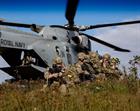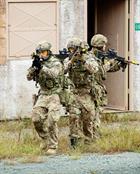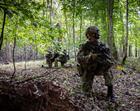Marines practise going behind enemy lines to save aircrew
Royal Marines staged a ‘Hollywood rescue mission’ as they practised their new role saving downed aircrew from Britain’s new aircraft carrier from behind enemy lines.
The men of Lima Company, 42 Commando, ‘fought’ their way through the Virginia undergrowth alongside US Marines to haul injured fliers to safety – a new highly-specialised mission which has been permanently assigned to the Royal Marines, based at Bickleigh Barracks in Plymouth.
With the return of fast-jet operations, it’s possible an F-35 Lightning might come down on a mission over hostile soil and its pilot forced to bail out – a scenario played out on the big screen by Owen Wilson and Gene Hackman in Behind Enemy Lines.
In that Hollywood blockbuster, a specialist marines team waited on a US carrier for the green light to extract downed pilot Wilson from the war-torn former Yugoslavia.
This is a great new role for the Royal Marines and it is really exciting to be involved in developing this new skill from the ground up.
Corporal Richard Dowling
For Behind Enemy Lines, read Exercise Lightning Angel, and US Marine Corps Base Quantico for the war-torn former Yugoslavia as Lima perfected their new role as the Corps’ experts in Joint Personnel Recovery – which means they will be working closely with HMS Queen Elizabeth for the foreseeable future.
“This is a great new role for the Royal Marines and it is really exciting to be involved in developing this new skill from the ground up,” said Corporal Richard Dowling, aged 33.
In fact, the mission assigned to Lima troops extends beyond ‘simply’ rescuing aircrew who’ve gone down deep in hostile territory. It encompasses any mission to recover what are known as isolated personnel stranded in a ‘non-permissive environment’; this could include downed pilots, UK nationals or UK forces who have become separated from their Units.
Lima decamped to Quantico, 30 miles outside Washington DC, one of the US Marine Corps’ largest bases, where they were joined by two Merlin Mk4 helicopters from 845 Naval Air Squadron, permanently assigned to the Royal Marines to carry them into battle.
The Royal Marines’ hosts weighed in by providing Sea Hawk helicopters (the naval variant of the famous Black Hawk) and by giving the Brits use of their ranges.
The troops were going to carry out their rescue/extraction training at Camp Lejeune in North Carolina, but Hurricane Florence forced them to relocate to Quantico.
After a week dedicated to Joint Personnel Recovery, Lima switched to two weeks of live firing as groups of up to 30 marines at a time fired live ammunition in close proximity to each other – fully preparing them for working in hostile operational environments.
“As Sir Chris Hoy says it’s easy getting the bike up to speed the hard part is maintaining it,” explained 39-year-old Major Russell Sayer, Officer Commanding Lima Company.
“We are up to speed now with personnel recovery – but we are going have to work very hard to maintain this new skill now that we have it.”





